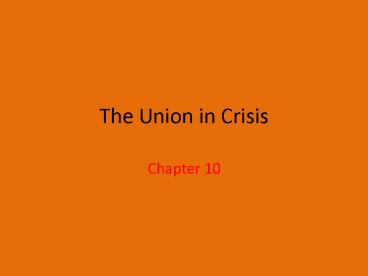The Union in Crisis PowerPoint PPT Presentation
1 / 19
Title: The Union in Crisis
1
The Union in Crisis
- Chapter 10
2
The North, a manufacturing society The South, an agricultural society
Cities and towns were trade centers Factories and farms produced goods Paid labor source, few slaves Many immigrants Cities and towns were few and far between Large plantations and small farms were source of wealth Enslaved labor force of African Americans Few immigrants
3
- The North and the South had very different views
of slavery.
4
Slavery and the North Slavery and the South
Few people had slaves and slavery ended by 1860. Slavery was an integral part of life with over 1 million enslaved African Americans.
Early in the 1800s, some northerners began to work for the abolition of slavery. Many believed God intended blacks to provide labor for whites.
Many northern states limited the rights and migration of free African Americans, so many white northerners had little contact with them. Southerners claimed that enslaved people were healthier and happier than northern wage earners.
5
- In the election of 1848, the two political
parties, the Democrats and the Whigs, split over
the issue of slavery and a third party was
formed, the Free-Soil Party.
6
Gov Lewis Cass of Michigan
Zachary Taylor
- The Democrats and Whigs were forced to address
the slavery issue.
- Both parties supported popular sovereignty,
having voters in a territory decide whether their
territory would be free or slave. - Kept with the tradition of American democracy. It
would also remove Congress from the controversy.
7
- Once again, the slavery issue was debated in the
Senate by three political leaders.
Henry Clay from the West
Daniel Webster from the North
John Calhoun from the South
8
Compromise of 1850
Calhoun and Websters positions on Clays
compromise during Senate debate
Calhoun Webster
Clays compromise did not give the South enough protection. The South would break away from the Union if it did not get its demands on the slavery issue. Any state had the right to secede if it disagreed with national laws. The states should rally to the cause of unity. Sectional compromise was needed in order to preserve the Union. Webster supported popular sovereignty.
9
The Compromise of 1850 finally became a law
stating that
The North The South
California would be admitted to the Union as a free state. Congress would pass a stricter fugitive slave law.
The territories of New Mexico and Utah would decide on slavery by a vote. Slavery would be enforced in Wash., DC, although the slave trade would be abolished.
The compromise brought calm to the nation, but
larger crises loomed.
10
- The Fugitive Slave Act, part of the Compromise
of 1850, required all citizens to catch and
return runaway slaves.
11
- nullified the Fugitive Slave Act.
- enabled state officials to arrest slave catchers
for kidnapping free African Americans. - increased northern white support of abolitionism.
Some Northern states passed personal liberty
laws. These laws
12
Free blacks and Northern abolitionists organized
an escape network called the Underground
Railroad.
- The map shows the routes conductors used to
lead enslaved blacks to freedom.
13
- A fugitive slave from Maryland, Harriet Tubman,
was called the Black Moses because she led so
many people to freedom on the Underground
Railroad.
14
Popular novels condemned slavery, gaining
northern support for abolition and infuriating
the South.
- White abolitionist Harriet Beecher Stowe wrote
Uncle Toms Cabin that gave readers compassion
for the nonviolent enslaved Tom. - Black abolitionist Martin Delany wrote Blake in
which the enslaved Blake chooses to rebel
violently against slavery.
15
The legislation divided Nebraska territory into two separate areas. Residents of both Kansas and Nebraska voted to allow or outlaw slavery. Congress assumed Kansas would become a slave state and Nebraska a free state. Northerners and Southerners went to Kansas to influence the vote.
Kansas-Nebraska Act was enacted in the spring
of 1854.
16
- Pro-slavery Southern Border Ruffians from
Missouri attacked the anti-slavery town of
Lawrence, Kansas. - Northern abolitionist John Brown responded by
killing five pro-slavery settlers. - Both sides armed and readied for battle.
Passage of the Act set off violence between
Northerners and Southerners.
17
- Describing the violence in Kansas, reporters
called the territory Bleeding Kansas.
18
- The dispute over Kansas
- The South wanted Kansas to be a slave state. The
North wanted Kansas to be a free state.
In 1861, after the Civil War started, Kansas
joined the Union as a free state.
19
- Violence over the slavery issue broke out in the
U.S. Senate. Southern Representative Brooks badly
beat Northern Senator Sumner.
- The national tension over slavery grew wider and
deeper, with violence spreading even to Congress.

